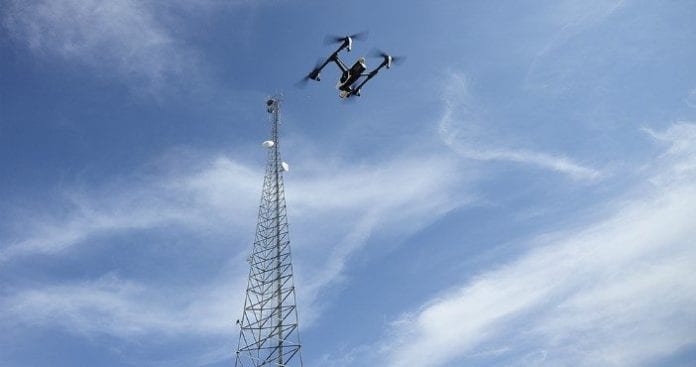Look up, and it soon may be likely that you’ll spot a drone, particularly if you’re at a concert or an outdoor public event. Commercial-grade drones are proving to be more than a novelty, and the industry is evolving at a rapid pace. Drone sales are expected to surpass $12 billion in 2021. The autonomous devices are typically used in areas that are too risky or challenging to access by other means, and have proved useful in industries such as military, security, construction, utility, insurance, and others.
Perhaps most significantly, however, drones have begun to contribute to public safety. This is made possible thanks, in part, to high-definition, 360-degree cameras and enterprise small cells. A small cell is a low-power cellular station that connects to a service provider’s network via broadband. Mobile network operators can then leverage small cells fixed to drones to provide spot coverage and extended service in areas where access is otherwise limited or unavailable.
Such drones can serve as an additional safety resource during public events — such as your next concert, festival, or triathlon. However, the technology can also provide assistance in remote locations or during emergencies, providing first responders and mobile customers with vital connectivity. Researchers at the University of North Texas, for example, are exploring the use of drones to fly portable cellular base stations into areas where cell service is down or absent.
Mini, autonomous flying cell towers are the future of wireless communication in remote or hard-to-access areas, marking a major advancement in connectivity in times when it can matter most. There are only a couple of challenges standing in the way of greater adoption by network operators: drone life and network coverage.
Fortunately, the length of time a drone can stay airborne prior to recharging is improving quickly. The Persistent Aerial Reconnaissance and Communications (PARC) drone from CyPhy Works can climb 400 feet and stay up for a full week. But the PARC is tethered to the ground, so it has a limited range and can only go so far from base.
Using Samsung small cells, Verizon is pushing the limits of flight time and has tested drones that can fly up to 16 hours straight. The company aims to pair such long-duration windows with mobile operations centers on the ground to provide first responders on a site access to regular smartphone data sessions, sharing texts, photos, and voice calls.
In the aftermath of natural disaster like hurricanes, Verizon and AT&T have both used drones to aid network recovery efforts. Verizon started using drones last year to inspect cell sites rendered inaccessible by flood water. Field crews can use the drones to remotely inspect the sites to plan the needed repair efforts. After Hurricane Harvey hit Houston, AT&T was ready to go with drones on standby to help speed massive network recovery efforts.
Verizon and Samsung also worked together to use a Samsung small cell to relay an LTE signal from the ground to an AATI drone, which is capable of flying up to 22,000-feet, in high winds, for 12 to 16 hours. The drones support systems that livestream images to public safety officials while simultaneously provided LTE connectivity for mission critical communications.
In regards to network coverage, Sprint has been busy testing its aerial small cell for the network as a way to expand its 2.5 GHz data service up to 10 square miles. The Sprint Magic Box was designed to improve coverage for customers, and it uses a dedicated cellular channel to the nearest Sprint cell tower instead of a broadband connection. A drone paired with a lightweight Magic Box may enable greater coverage and capacity to support temporary spikes in network traffic at large events, venues, and public gatherings. A flying Magic Box can also be used for emergency responses, sending data services into those remote or hard-to-reach locations following natural disasters.
AT&T has also announced plans to connect drones to its 4G LTE network for transmitting and receiving high-speed data. The company is currently making good use of drones to inspect cell towers and test distributed antenna systems on its network. Network inspections can prove challenging, particularly after storms or natural disasters. In such cases, drones can provide a safer, more efficient option for site checks. Site and network data from the drone can then be sent to a control center for analysis of the best course of action for maintenance or repairs.
Deutsche Telekom AG’s T-Mobile unit in the Netherlands has been using drones successfully for its network antenna inspections. Each drone employed uses an HD camera equipped with heat sensors and transmitters to provide real-time analysis of the data.
In the U.S., drones must fly only within visual line of site (VLOS) of the operator, which limits the range of flight to 1,000 to 2,000 feet on average (depending on the size of the drone). The FAA has developed special regulations for drones during emergencies to help track flight plans and prevent collisions. However certain industries, such as utility and construction, are seeking changes that would permit drone flight beyond a visual line of sight (BVLOS) when safe and appropriate at worksite locations.
AT&T is partnering with NASA to research traffic management that would support the safe and secure operation of drones in the national airspace. With updated regulations and the integration of new drone capabilities that include small cells for connectivity, drones may soon be an integral part of public safety, security and public events.

